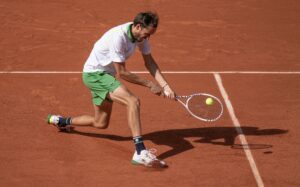The first Masters 1000 of the season is underway at Indian Wells. Provided that the rest of the “Big Four” are either sidelined or facing major question marks, most eyes are on World No. 1 Roger Federer. According to the ATP rankings, the Basel native has been the best player on tour over the last 52 weeks. The eye test does not differ. Precisely at Indian Wells last year, the Swiss superstar needed just 68 minutes to bulldoze arch-rival Rafael Nadal 6-2 6-3. Definition of a statement win right there.
Has Federer been playing the best tennis of his career since? That’s as subjective as it gets. Which version of Michael Jordan was better? The one oozing exuberance in 1986 that averaged 37 points per game; or the “I’m gonna beat you whenever I want, however I want, pick your poison” MJ of the second three-peat?
Don’t know about better, but I felt a case could be made about Federer being more dominant than ever before.
I dug deep into Federer’s career on the ATP World Tour, seeking to confirm or refute my hypothesis.
I went all the way back to 2002, the first year Federer qualified for the World Tour Finals, formerly known as the Masters Cup. Davis Cup and Olympics matches were included. On the other hand, Hopman Cup, Laver Cup, and other non-countable exhibitions were dismissed.
Winning Percentage
Federer has won 56 out of 60 matches since the start of BNP Paribas Open 2017, good for a respectable .933 winning percentage. As astoundingly superhuman as it may sound, that isn’t the best figure of the 36-year-old’s illustrious career. In fact, he eclipsed it in both 2005 and 2006.
52-week period: 93.33%
2006: 94.84%
2005: 95.29%
Dominance test status: Failure (0-1)
Points Accrued
In case you do not remember, the ATP used a different point scale before 2008. Don’t worry about that, I used the updated points breakdown for every year I examined.
Right, Federer skipped the 2017 clay season, whereas younger Federer used to dangle on the dirt. Should we just compare apples to oranges then? Not too fast. It’s possible to make a fair comparison on this end.
As of March 5th, the 20-time Grand Slam champion has accumulated 10,060 non-clay points. Let that sink in. I thought this had to be a personal record.
Nope.
While it’s Federer’s best mark of the last full decade, Cannibal Fed had already broken the 10K non-clay barrier for four straight seasons, between 2004 and 2007.
52-week period: 10,060
2007: 10,690
2006: 13,595
2005: 10,720
2004: 10,885
Dominance test status: Failure (0-2)
Points Per Tournament
The third empirical attempt at validating my hypothesis was based off an admittedly flawed metric. For a player adept at making deep runs at Majors and Masters, partaking in (and even winning) an ATP 250 tournament is detrimental.
In order for the comparison to be totally fair I excluded the Davis Cup and Olympics, which used to award ATP points for several years.
52-week period: 838.33
2007: 848.75
2006: 940.88
2005: 841.33
Dominance test status: Failure (0-3)
Dominance Ratio
I may have struck out swinging, but baseball rules don’t apply here. I took my talents to Tennis Abstract, where I quickly found the Holy Grail.
The Dominance Ratio measures “the percentage of return points won divided by the percentage of serve points lost.” The more dominant a player is on a per point basis, the higher the DR will be.
Pursuing a fair comparison, I excluded Federer’s clay statistics from each season’s results.
Over the past 52 weeks, Papa Roger has posted a hardly believable 1.49 DR, by far the best output of his lifetime.
52-week period: 1.49
2007: 1.38
2006: 1.40
2005: 1.38
2004: 1.40
Back in 2015, Novak Djokovic put together the greatest single season in men’s tennis history, as broken down by Juan José Vallejo in his article Searching for a Standard of Greatness. His Dominance Ratio? A measly 1.42.
The first time the Serbian turned into Terminator dates back to 2011. Djokovic kicked off his campaign on a 41-0 run. Yet, his DR between the Australian Open and the Rome Masters was just 1.46.
Dominance test status: Success!
Underlying reasons
In a cause-effect relationship, the Dominance Ratio is the effect, the end product. What is causing the surge in Federer’s numbers? My first thought pointed toward his enhanced backhand return. However, if you delve into the Return Points Won column, you’ll find out the Swiss used to win more receiving points than his current 40.0%. It’s actually his eighth best mark. Reminder: from here on out, the year-by-year data is excluding clay.
52-week period: 40.0%
2006: 42.0%
2005:41.7%
2004:41.5%
2003: 41.5%
Rather than putting up eye-popping overall return numbers, Federer is elevating his game to unprecedented heights right when it matters. Enter Break Point Conversion. Here are the five best ratios of his career, per Tennis Abstract. You be the judge.
52-week period: 36.2%
2006: 31.6%
2005:30.7%
2004: 30.5%
2003: 29.9%
No typo, I promise. The magnitude of the leap forward is bonkers. The 36-year-old managed to turn a fatal flaw into a strength. No wonder the Federer is now sitting atop the newly created ATP Under Pressure Leaderboard.
Last but not least, Federer’s deadliest weapon has extra ammunition now. And it is not close either. Check out the Service Points Won breakdown.
52-week period: 73.3%
2014: 71.1%
2010: 71.1%
2009: 71.0%
2007: 70.3%
Conclusion
By claiming Federer is a beast I am basically stating the obvious. Nevertheless, his upgraded efficiency at converting break points, along with his ever-improving service game, has allowed the World No. 1 to exert more domination over his peers than ever before.
In other words, Federico Delbonis and the rest of potential foes in Palm Springs are in big trouble against Tyrant Roger.
Main Photo:
Embed from Getty Images






